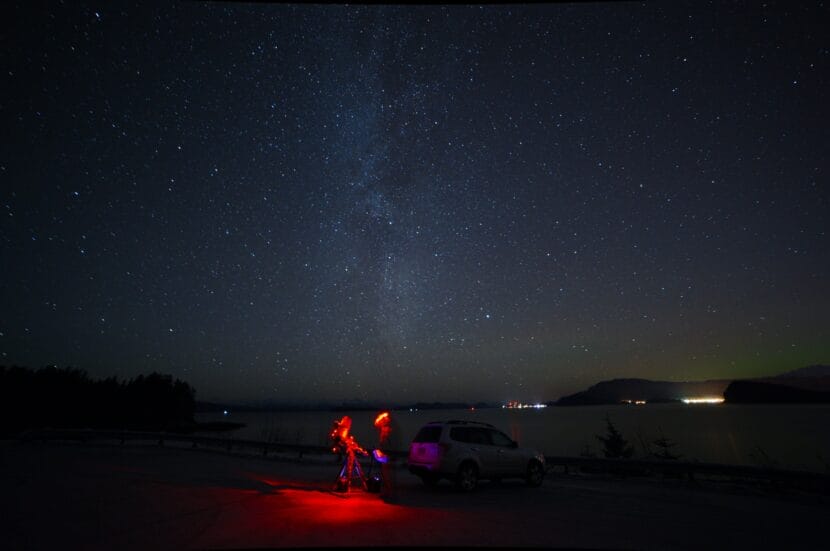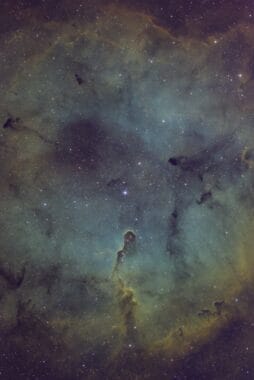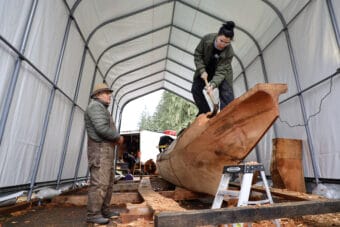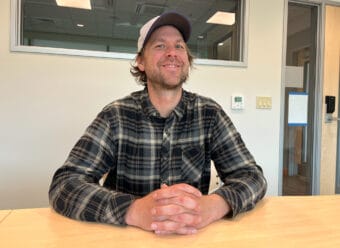
This is Tongass Voices, a series from KTOO sharing weekly perspectives from the homelands of the Áak’w Kwáan and beyond.
Sandwiched between Juneau-Douglas High School and Harborview Elementary is the Marie Drake building, home to Juneau’s planetarium. Volunteers host free lectures, First Fridays, films, and field trips.
Dave Hanson is an astrophotographer and one of the planetarium’s board members. He says they hope to keep the planetarium open after the city takes over the building from the school district. His most recent lecture was about rogue planets.
Listen:

This transcript has been lightly edited for clarity.
Dave Hanson, speaking to the audience: So, welcome to the Marie Drake Planetarium. If you weren’t planning on being at the planetarium, you’re here now. Enjoy the show.
Interview transcript: Okay, I’m Dave Hanson. I moved to Juneau seven years ago. And when we were thinking about moving here, we started googling Juneau. And one of the things we found was a planetarium, which just amazed me in a town the size of Juneau.
Speaking to the audience: So tonight’s show is called “Going Rogue in the Cosmos.” The main thing I think we’re going to be talking about is mostly rogue planets. And we’ll talk a little bit in a bit about what that is.
I woke up yesterday morning. And there was big news from the Euclid Space Telescope — which is yet another space telescope — that it found a bunch of rogue planets. And how timely is that?
Interview transcript: I’ve always been interested in astronomy. I do astrophotography, I had done that previously. So when I got here, I definitely wanted to check it out. I met the people here and started volunteering, stacking chairs, and eventually started doing presentations and joined the board. And it’s been a great experience.
Speaking to the audience: Euclid is a little bit different. It’s what they call a survey telescope. So it’s going to be actually mapping the entire sky. So what it saw were 50 rogue planets, kind of in one shot. So what it did was, it looked at Orion. Can you see Orion in this photo? The constellation. We’ve got the head up there, we’ve got the belt, the sword, the feet.
Interview transcript: To me, one of the most rewarding things are the kids. And the questions they ask are just so on point. And they’re so curious. So we bus in kids from all the schools. I don’t know how many we did this year. Last year, I think we brought 800 kids to the planetarium.
Speaking to the audience: Up here, we kind of see this dark, dusty area with some glowing stuff up there. This is an object called M78, or Messier 78. And it’s a star-forming region. Well, Euclid took a picture of it, and we finally got some of the first science photos from Euclid. Just in this one image, they found 300,000 new objects that we didn’t know about. So these are new stars, planets, protoplanets. And they found 50, approximately 50, planets that aren’t associated with stars — rogue planets. And this is kind of way more than we thought we would find.
Interview transcript: Yeah, there was a lot of anxiety among the board members, you know, when we first heard about the consolidation. Our hope is that, you know, if this becomes kind of a community center, this whole facility, that we can be one of the anchors for that, you know, as a long-standing organization. And that’s one of the things we’re trying to do is, you know, work with other nonprofits in the community.
Speaking to the audience: That’s kind of the shocking thing. We think of, you know, our galaxy and our universe being very ordered in these star systems with planetary systems around them, which was a surprise, even, that so many of those existed. And now we found that there’s all these planets that aren’t even associated with stars. The more we know, the more we don’t know. So there’s plenty — don’t worry, all the discoveries have not been made yet.


